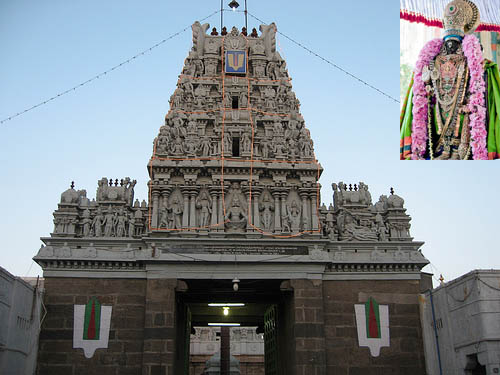Name of the Temple |
- Śhrī Pārthasārathi Temple
|
Location |
- It is located at Triplicane, near the famous Marina beach in Chennai.
|
| How to reach there? |
- By Air: The nearest airport is the Chennai airport, 17 km. To reach Pārthhasārathhiswāmi temple take from the airport the National Highway 32.
- By Train : In Chennai the nearest railway station is Chennai Central. It is located 4 km north of Pārthhasārathhiswāmi.
- By Road: Chennai is connected by the National Highway 32 from Chennai to Nagapaṭṭinam, 4 from Chennai to Puṇe, 16 from Chennai to Vijayawāḍā and 716 from Ananthpur to Chennai.
|
Rulers/builders and Time Period |
- The Pārthasārathi temple in Chennai has its origin back in 8th century.
- It was built by the Pallavas king Narasimhavarman I and later reformed by the Vijayanagar Kings during 11th century.
|
Deity/Deities |
- The temple, dedicated to Lord Kriṣhṇa (Pārthasārathi ), houses images of five incarnations of Vishnu.
- It also has a small shrine dedicated to Vedavalli Ammai, Vishnu's consort.
- Pārthasārathi in the sanctum sanctorum is in a standing posture facing east, holding in his right hand the divine conch called the Pānchhajanyam. His left hand is in Dhāna Mudhrā indicating his divine feet.
|
Architecture Style |
- The temple and the area Thiru allikkeni derives the name from the Holy tank. It is said Goddess Mahālakṣhmi herself was born here as Vedhavalli to Sage Bhrigu. Lily flowers bloomed in this tank. This tank consists of five sacred wells. It is said that its waters are holier than the Ganges.
- Eastern side Rājagopuram and other structures are said to have buidt by Thondamān Chakravarthi, who ruled this parts from Kālahasthi.
|
Special Reference to Fine Arts |
- The Mahāmanḍapam and the Manḍapam in front of Pārthasārathi Swāmi called Thiruvāimozhi Prabandha Manḍapam, show pre-Pallava architecture, indicating that the manḍapams are later annexures to original shrine.
- Except Śhrī Pārthasārathi Swāmi shrine, other shrines have been renovated in the beginning of the century and the shrine of Śhrī Vedhavalli Thāyār and the 36 pillared manḍapam in front of the temple were built in the later part of the last Century.
|
Other Special Features |
- The temple has grand Brahmothsavams for Śhrī Pārthasārathi Swāmi during the Tamil month of chittirai (mid April-mid May),on the same month Udayavar uthsavam is also celebrated in special manner.
- In the month of vaigāsi(mid May-mid June) Śhrī Varadarajar uthsavam, Śhrī Nammālwār uthsavam(vaigāsi-visākam) and vasanthothsavam are celebrated. Śhrī Azhagiyasingar uthsavam during the Tamil month of aani (mid June-mid July).There are also grand uthsavams for Śhrī Rāmānuja(mid April-mid May) and Śhrī Manavālamamunigal(mid Oct-mid Nov) besides uthsavams for Ālwars and Āchāryas. Vaikunta Ekādaśhii and during the Tamil month of Mārgazhi draws lot of pilgrims.
- The literal meaning of 'Pārthasārathi ' is the charioteer of Pārtha. According to the great Indian epic 'Mahabharata' 'Partha' meant Arjuna while sārathi is meant a charioteer. In the epic, it is said during the great battle of Mahabharata, Lord Krishna was the charioteer of Arjuna. In the epic Arjuna or Pārtha was a brave warrior and Lord Krishna was a good friend, philosopher and guide to Partha or Arjuna.
- Though the common features of ancient temples are very much prevalent in this ancestral temple, it has some striking features, which makes the temple outstanding among others.
|
Other Special Remarks |
- According to the Purāṇas, Lord Kriṣhṇa was the charioteer for Arjuna during the Mahābhāratha war when he gave a discourse which became the holy book- Bhagavad Gīthā. Hence, the God, Śhrī Pārthasārathi 's face is full of scars created by the arrows of the great Bhhīṣhma in the Kurukṣhethra war.
- Other interesting thing is that, God Kriṣhṇa is seen with a moustache and without his weapon Chakra. The reason attributed is that he promised not to take weapons in the Mahābhāratha war and hence he has only his conch. As He was the charioteer He sported the moustache keeping with the tradition.
- The Uthsavar also has only a stick and not his mace as found with others. This is because the Lord was born in a cowherd clan.
- It is one among the 108 dhivyadheśhams or holy abodes of Lord Vishnu.
|
Special Reference to Performing Arts: |
- Among the 12 Āzhwārs three of them namely Péyāzhwār, Thirumazhisai ālwār and Thirumangai ālwār have sung on the different forms of God in this temple.
- All the exquisite viruthams such as `Palliyil Othi Vanthadhor Siruvan' (Thirumangai Āzhwār Pāsuram) about Thiruvallikeni deity and `Śhankha Chakra’ - Draupadi Māna Samrakshana shlokam were thematic to the metaphors of the temple.
- Dīkṣhithar composition, “śhrī pārthasārathina” (shuddhadhanyāsi, rūpakam) refers to the temple of Pārthasārathi . Śhankja Chakra (Pūrṇachandrikā), the Chalamela varṇam (Nāttakurnji) and Pārthasārathe (Suruti) are the unique compositions of Dīkṣhithar about Lord Pārthasārathi .
- Pārthasārathi nannu - Madhyamāvathi - Pūchi Srīnivāsa Iyengār;
- Ninnu sevinchina and Pārthasārathini sevimpani - Yadhukulakāmbhodi - Subbarāya Dīkshitar;
- Śhrī Pārthasārathi - Bhairavi - Mysore Sadghāśhiva Rao
- Pārthasārathi ni - Yadhukula kāmbhodi - Chengalvarāya Śhāstri are other few famous compositions about this Lord.
|
Bibliography |
|















